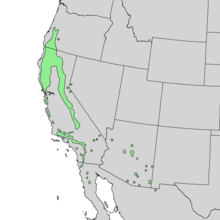Quercus chrysolepis
| Quercus chrysolepis | |
|---|---|
 |
|
| Leaves and acorns | |
| Scientific classification | |
| Kingdom: | Plantae |
| (unranked): | Angiosperms |
| (unranked): | Eudicots |
| (unranked): | Rosids |
| Order: | Fagales |
| Family: | Fagaceae |
| Genus: | Quercus |
| Section: | Protobalanus |
| Species: | Q. chrysolepis |
| Binomial name | |
|
Quercus chrysolepis Liebm. 1854 |
|
 |
|
| Natural range of Quercus chrysolepis | |
| Synonyms | |
|
|
Quercus chrysolepis, commonly termed canyon live oak, canyon oak, golden cup oak or maul oak, is a North American species of evergreen oak that is found in Mexico and in the western United States, notably in the California Coast Ranges. This tree is often found near creeks and drainage swales growing in moist cool microhabitats. Its leaves are a glossy dark green on the upper surface with prominent spines; a further rapid identification arises from the leaves of canyon live oak being geometrically flat. They are often sympatric with Quercus agrifolia and several other oak species. Fossil data supports a much wider distribution throughout the western United States during the early Holocene period.
Native Americans used the acorns of this species as a food staple, after leaching of the tannins; moreover, its roasted seed is a coffee substitute. After forest fires, canyon live oak regenerates vigorously by basal sprouting, and the clonal diversity of this species has been shown to be high.
Quercus chrysolepis is an evergreen tree with significant-sized spreading, horizontal branches, and a broad, rounded crown; it attains a height of six to thirty meters (20-100 feet) and is often found in a shrubby growth form. The trunk diameter can range from 30 to 100 centimeters. The elliptical to oblong leaves are 2.5 to 8.0 centimeters (1.0-3.2 inches) in length with widths of about half that dimension; moreover, leaves are short-pointed at the tip, but rounded or blunt at base. Although the leaves appear generally flat, they may have edge margins slightly turned under, typically with spiny teeth, particularly on young twigs. These leathery leaves are a glossy dark green above, with a nether surface a dull golden down, often becoming gray and nearly glabrous the second year.
...
Wikipedia
